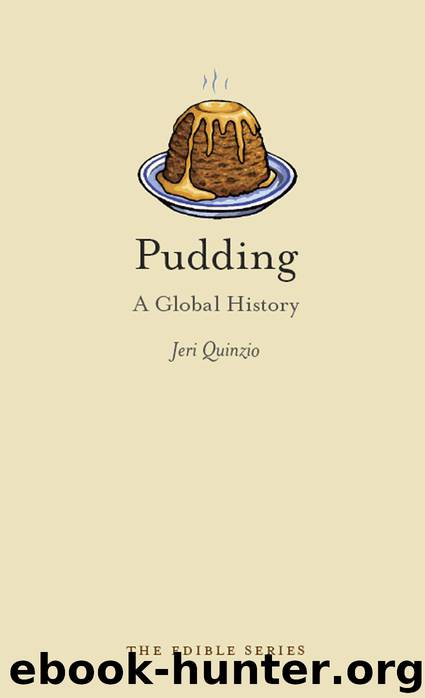Pudding by Jeri Quinzio

Author:Jeri Quinzio
Language: eng
Format: epub
Publisher: Reaktion Books
7
Bread Pudding
Hurrah for puddin’-owning.
Norman Lindsay, The Magic Pudding, 2006
Bread pudding, usually thought of as a thrifty way to turn stale bread into an economical dessert, started out as a rather more elegant and expensive dish. The fourteenth-century French household guide Le Ménagier de Paris included directions for making a version called a taillis. A Lenten variety was made with bread and biscuits combined with raisins, apples, almond milk, saffron and sugar. It was not cooked: hot almond milk was simply poured over the bread and other ingredients and the mixture was left to set.1
By the seventeenth century, an English dish called a white-pot was being made with ‘fine’ (good-quality) bread, rich cream, eggs and spices. White-pots were distinguished by being baked instead of boiled in a bag like most puddings of their day. A Devonshire white-pot was so called because Devonshire was a dairy farming county known for its excellent cream. A typical white-pot recipe, from The Compleat Cook by Nathaniel Brook published in 1658, called for ‘a penny Loaf of fine bread sliced very thin’ along with cream, eggs, nutmeg, sugar, butter, salt and ‘a handfull of Raisins of the Sun’. Robert May had a similar recipe in the 1685 edition of The Accomplisht Cook but he added ‘pippins’ (a variety of apple) boiled to ‘pap’. May directed the cook to ‘cut some sippets [bread cut into small pieces] very thin and dry them before the fire’. When the sippets and pippins were ready, he layered them in a pan, poured on the cream mixture and baked it.
Download
This site does not store any files on its server. We only index and link to content provided by other sites. Please contact the content providers to delete copyright contents if any and email us, we'll remove relevant links or contents immediately.
The Bread Bible by Rose Levy Beranbaum(2896)
Best of Jane Grigson by Jane Grigson(2871)
Classic by Mary Berry(2838)
Sweet by Ottolenghi Yotam & Goh Helen(2810)
Flavor Flours by Alice Medrich(2648)
Sweet by Valerie Gordon(2272)
The Anne of Green Gables Cookbook by Kate Macdonald(1932)
Vegan Desserts by Hannah Kaminsky(1856)
Fabulous Party Cakes and Cupcakes by Carol Deacon(1752)
Doggy Desserts: 125 Homemade Treats for Happy, Healthy Dogs by Cheryl Gianfrancesco(1596)
The French Baker by Sébastien Boudet(1515)
Making Artisan Chocolates by Andrew Garrison Shotts(1513)
Bakeland by Marit Hovland(1508)
Seriously Bitter Sweet by Alice Medrich(1496)
A New Way to Bake: Classic Recipes Updated with Better-for-You Ingredients from the Modern Pantry by Editors of Martha Stewart Living(1480)
Teens Cook by Megan Carle(1453)
The Magnolia Bakery Cookbook: Old Fashioned Recipes From New Yorks Sweetest Bakery by Jennifer Appel & Allysa Torey(1449)
Baked Occasions by Matt Lewis(1387)
Gluten-Free Classic Snacks: 100 Recipes for the Brand-Name Treats You Love by Nicole Hunn(1376)
